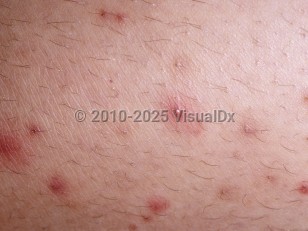Folliculitis - Hair and Scalp
See also in: Overview,AnogenitalAlerts and Notices
Important News & Links
Synopsis

The etiology of folliculitis can be variable, with bacterial, fungal, viral, parasitic, and noninfectious causes reported. A detailed history of comorbid conditions, exposures, and medications, in conjunction with appropriate ancillary testing, can be helpful.
In immunocompetent patients, bacterial folliculitis may be considered, often due to a predisposing factor that allows for increased bacterial burden on the skin surface. Staphylococcus aureus and Streptococcus species are commonly implicated. Predisposing factors include nasal carriage of S aureus, occlusion, maceration, vigorous application of topical medications, shaving (folliculitis barbae / sycosis barbae), and exposure to oils and certain chemicals. Both methicillin-sensitive S aureus (MSSA) and methicillin-resistant S aureus (MRSA) can cause folliculitis, which may be associated with nasal carriage of the organism. Although MRSA skin infections most commonly present as erythematous abscesses and/or cellulitis, MRSA folliculitis is becoming increasingly prevalent. MRSA folliculitis may have a unique presentation. Whereas MSSA folliculitis is usually localized to the axillae, beard area, buttocks, and extremities, MRSA folliculitis has been reported to present in the periumbilical area, chest, flank, and scrotum.
Gram-negative folliculitis is more common among individuals taking long-term antibiotics (such as for the treatment of acne), and this may also be seen in the scalp.
Bacterial folliculitis of the scalp, especially in children, should be distinguished from folliculitis that may accompany tinea capitis, especially from infection from zoophilic organisms such as Microsporum canis. Here, perifollicular pustules may be isolated or associated with boggy plaques (kerion). Often in these cases, cervical lymphadenopathy may be noted due to the severity of the infection. Demodex folliculitis on the scalp has been rarely reported in adults. In this condition, pustules are associated with erythema, scale, and nonscarring alopecia. Eosinophilic pustular folliculitis of infancy classically presents with scalp involvement.
A foreign body reaction caused when tightly kinked hair is shaved is called pseudofolliculitis and may be seen over the beard area. It may become superinfected with Staphylococcus epidermis and result in pustule formation. A similar entity with tightly kinked hair over the nape of the neck is called folliculitis keloidalis nuchae. Herpetic folliculitis may also be seen in the beard area. This occurs when the herpes simplex virus is inoculated into the hair follicle from shaving. A unilateral cluster of follicular papules or pustules is seen. Fungal folliculitis or kerion secondary to Trichophyton verrucosum or other zoophilic species is an infrequent cause of beard folliculitis in adults. Deep-seated follicular pustules are seen.
Codes
L73.9 – Follicular disorder, unspecified
SNOMEDCT:
13600006 – Folliculitis
Look For
Subscription Required
Diagnostic Pearls
Subscription Required
Differential Diagnosis & Pitfalls

Subscription Required
Best Tests
Subscription Required
Management Pearls
Subscription Required
Therapy
Subscription Required
Drug Reaction Data
Subscription Required
References
Subscription Required
Last Updated:09/14/2025
 Patient Information for Folliculitis - Hair and Scalp
Patient Information for Folliculitis - Hair and Scalp- Improve treatment compliance
- Reduce after-hours questions
- Increase patient engagement and satisfaction
- Written in clear, easy-to-understand language. No confusing jargon.
- Available in English and Spanish
- Print out or email directly to your patient


